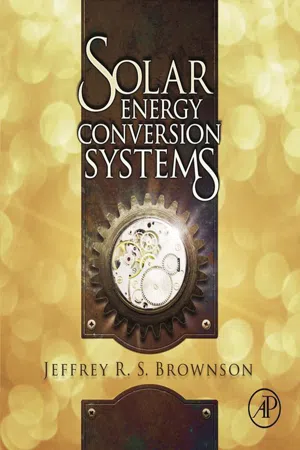
- 480 pages
- English
- ePUB (mobile friendly)
- Available on iOS & Android
Solar Energy Conversion Systems
About this book
Solar energy conversion requires a different mind-set from traditional energy engineering in order to assess distribution, scales of use, systems design, predictive economic models for fluctuating solar resources, and planning to address transient cycles and social adoption. Solar Energy Conversion Systems examines solar energy conversion as an integrative design process, applying systems thinking methods to a solid knowledge base for creators of solar energy systems. This approach permits different levels of access for the emerging broad audience of scientists, engineers, architects, planners, and economists. Traditional texts in solar energy engineering have often emerged from mechanical or chemical engineering fields. Instead, Solar Energy Conversion Systems approaches solar energy conversion from the perspectives of integrative design, environmental technology, sustainability science, and materials science in the wake of amazing new thin films, polymers, and glasses developed by the optoelectronics and semiconductor industries. This is a new solar text for the new generation of green job designers and developers. It's highlighted with vignettes that break down solar conversion into useful stories and provides common points of reference, as well as techniques, for effective estimation of evolving technologies.- Contextualizes solar conversion for systems design and implementation in practical applications- Provides a complete understanding of solar power, from underlying science to essential economic outcomes- Analytical approach emphasizes systems simulations from measured irradiance and weather data rather than estimations from "rules of thumb"- Emphasizes integrative design and solar utility, where trans-disciplinary teams can develop sustainable solar solutions that increase client well-being and ecosystems services for a given locale
Frequently asked questions
- Essential is ideal for learners and professionals who enjoy exploring a wide range of subjects. Access the Essential Library with 800,000+ trusted titles and best-sellers across business, personal growth, and the humanities. Includes unlimited reading time and Standard Read Aloud voice.
- Complete: Perfect for advanced learners and researchers needing full, unrestricted access. Unlock 1.4M+ books across hundreds of subjects, including academic and specialized titles. The Complete Plan also includes advanced features like Premium Read Aloud and Research Assistant.
Please note we cannot support devices running on iOS 13 and Android 7 or earlier. Learn more about using the app.
Information
Sun-Earth Geometry
Abstract
Keywords
Table of contents
- Cover image
- Title page
- Table of Contents
- Quote Page
- Copyright
- Acknowledgements
- Chapter 01. Introduction
- Chapter 02. Context and Philosophy of Design
- Chapter 03. Laws of Light
- Chapter 04. Physics of Light, Heat, Work, and Photoconversion
- Chapter 05. Meteorology: the Many Facets of the Sky
- Chapter 06. Sun-Earth Geometry
- Chapter 07. Applying the Angles to Shadows and Tracking
- Chapter 08. Measure and Estimation of the Solar Resource
- Chapter 09. Solar Energy Economics
- Chapter 10. Solar Project Finance
- Chapter 11. The Sun as Commons
- Chapter 12. Systems Logic of Devices: Patterns
- Chapter 13. Systems Logic of Devices: Optocalorics
- Chapter 14. Systems Logic of Devices: Optoelectronics
- Chapter 15. Concentration—The Pattern to Manipulate Light
- Chapter 16. Project Design
- Appendix A. Energy Conversion Systems
- Appendix B. Numeracy and Units in Solar Energy
- Bibliography
- Index